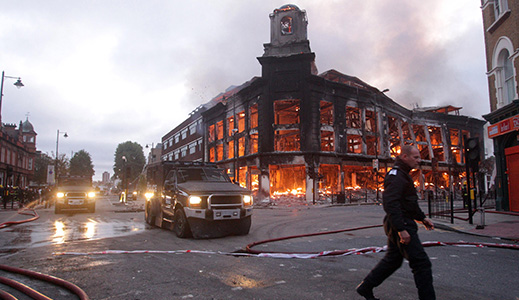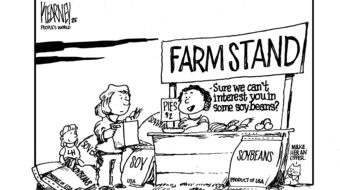
LONDON – Riot-scarred Tottenham began picking up the pieces Sunday from a night of violence that local trade unionists warned could erupt anywhere in Britain due to unemployment and social alienation.
Fires still smouldered following running battles through streets in the north London borough of Haringey.
Reports of injuries including stabbings among members of the public could not be confirmed today however two police officers were hospitalised and 24 others injured in the fighting.
At least 42 people were arrested.
Haringey Trades Council secretary Keith Flett was one of many local community leaders working to calm the area down after peaceful protests over a fatal police shooting spiralled into violence on Saturday night.
But he warned that communities across Britain were facing the same problems with the whole country “going back again” to the ’70s and ’80s.
“It happened here but it could happen anywhere.
“I don’t think it’s anything unique about Tottenham,” he said.
The rioting broke out following a march by around 300 residents to Tottenham police station over the shooting dead of local father of four Mark Duggan by an officer on Thursday night.
Mr Duggan had been a passenger in a minicab pulled over by police around 6.15pm on Ferry Lane Bridge in Tottenham Hale in what was called a “pre-planned” event under Operation Trident, which investigates gun crime in the African and Caribbean communities.
It is understood that Mr Duggan was shot twice in the face with a submachine gun, while an officer shot once in the chest was saved by the bullet jamming in his radio. It is unclear who shot the officer.
The incident has been referred to the Independent Police Complaints Commission but locals angry at the authorities’ muted response gathered at Mr Duggan’s home on the Broadwater Farm housing estate and marched to Tottenham police station.
It is unclear how the clashes began but within hours the streets resembled a warzone, with shops burgled and buildings and vehicles including police cars and a double-decker bus torched.
Looting spread to the nearby Tottenham Hale Retail park with high-street stores such as Currys targeted.
Mr Flett said today that it was ironic that a police operation to prevent violence had actually managed to provoke it.
There was “obviously a lot of anger” following Mr Duggan’s death but tensions had been breeding for a while, he said.
Haringey has one of London’s highest official unemployment rates at 8.8 percent.
There is just one vacancy for every 54 jobseekers for every job in the borough.
Mr Flett said there were problems with gun crime and knife crime but the borough was also suffering from a brutal economy and cuts to public services.
Just last week it lost eight of its 13 youth clubs to the Con-Dem cuts.
Local teenagers told reporters that the closures would fuel gang violence and rioting, Mr Flett said.
His concerns were echoed by Labour mayoral candidate Ken Livingstone.
“The economic stagnation and cuts being imposed by the Tory government inevitably create social division,” warned Mr Livingstone.
“As when Margaret Thatcher imposed such policies during her recessions this creates the threat of people losing control, acting in completely unacceptable ways that threaten everyone, and culminating in events of the type we saw in Tottenham.”
Reposted from Morning Star.
Photo: Police vehicles drive past a fire in a building in Tottenham, north London, Aug. 7, after a demonstration against the death of a local man turned violent and cars and shops were set ablaze.(AP/Lewis Whyld/PA Wire)










